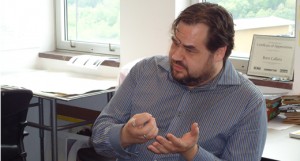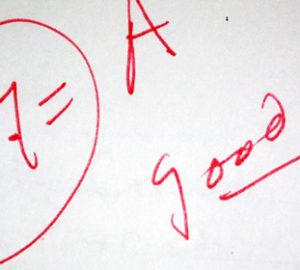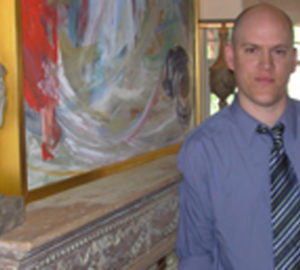
Brett Callero, professor of foundations with a specialty in graphic design, focuses his classes on culling creativity, the fundamentals and how students can improve their grades through enjoying the work process. He earned an M.F.A. in painting from SCAD in Savannah in 2004, and began teaching foundations at SCAD Atlanta in 2007.
“Most of my experience comes from the private sector. I was a graphic designer and art director in Chicago for a number of years,” said Callero. He hopes to share his real world experience and knowledge to his students. “I think people come to SCAD because art and design is such a high priority, where at a liberal arts college it may be their fifth priority, and [at SCAD] everything is related to art, design and is job-oriented,” Callero said.
SCAD offers a high degree of specialization within the student’s desired major. Classes are structured to reach across the curriculum and expose students to a variety of methods and practices. Every class brings creativity to the forefront and weaves elements of artistic design into the fabric of the syllabus, according to Callero.
“I teach in a department that’s the core of the school. When I’m dealing with colleagues in other departments, there isn’t a lack of communication,” Callero said, regarding the necessity of core classes. “From a faculty stand-point, I think we’re second to none, and students that come here know that it’s an intense environment, but we’re preparing them for something that they’ll be doing for the rest of their lives, hopefully.”
The average undergraduate SCAD student’s workload is often a minimum of 20 hours outside of class. It’s a creative environment that pushes students to perform at a high level, and the faculty encourages direct communication with students. “We have more face time here probably than any other school. The students have to take us up on that offer, but we make ourselves extremely available,” said Callero, on the subject of student-professor relationships. He also said that meeting with a professor after class or taking advantage of extra-help sessions can provide answers to craftsmanship, concept or mechanics questions.
Callero has confidence that students can bridge the gap between work and fun by taking pride in their work and enjoying the process. “I stress the work aspect, but I also stress the fun aspect. People that go into creative fields for a living are motivated and driven by doing what they love to do,” said Callero. “I love getting up and going to work every morning, because I work in what I call an idea factory, where I am constantly being inspired by students, hopefully, just as much as I am inspiring them.”
Callero explains to students that taking pleasure in their work can balance the time-intensive arduousness of it. He suggests making work fun, because the reward will be in the process, rather than the product. He believes that creativity is bolstered by having fun. However, the definition of creativity, according to him, has been misinterpreted.
“The concept of creativity has been manipulated within my lifetime and absolutely within [the student’s] lifetime,” said Callero. “Think of it this way: I saw an ad for coffee creamer, and they’ve got these different flavors, but their marketing [to the consumer] is that you are really a creative person if you choose the mint chocolate versus the regular. That’s not being creative. The word itself has been manipulated so much [now] that we don’t even know what it means.”
Callero defines creativity as a mastery of skills and the application of those skills. He encourages being creatively original through execution and integrity of the idea. An advantage of SCAD’s creative environment is that even when outside of class, ideas are continually being thought out and modified.
“Some of the things I’m teaching my students, they already instinctively know, but do they really understand it? A big thing for me is not turning it off while you’re not in school,” said Callero, explaining that students should always be thinking about the project at hand. “Students don’t quite realize that this is all immersive. When [students] aren’t in my classroom they should still be thinking about class.”
Callero recommends that students become aware of what’s going on around them and effectively use those observations to go past the first idea for a project. “Creative thinking is such a valuable skill. Students can take that with them even if they don’t work as a fashion designer, graphic designer or fine arts. That skill will benefit [students] no matter where they go,” said Callero.
The fundamental core classes at SCAD carry over into every major. Even if seemingly unrelated, the principles learned in foundations classes can greatly improve a student’s understanding of their own process, as well as develop the skills necessary to create their own method.
Correction, April 8: The original version of this article misstated Professor Callero’s degree from SCAD. He holds an M.F.A, not an M.A.























